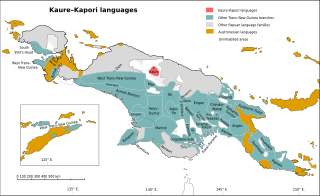Related Research Articles
Unserdeutsch, or Rabaul Creole German, is a German-based creole language that originated in Papua New Guinea as a lingua franca. The substrate language is assumed to be Tok Pisin, while the majority of the lexicon is from German.
The Border or Upper Tami languages are an independent family of Papuan languages in Malcolm Ross's version of the Trans–New Guinea proposal.
The Yalë language, also known as Yadë, Nagatman, or Nagatiman, is spoken in northwestern Papua New Guinea. It may be related to the Kwomtari languages, but Palmer (2018) classifies it as a language isolate.
Sulka is a language isolate of New Britain, Papua New Guinea. In 1991, there were 2,500 speakers in eastern Pomio District, East New Britain Province. Villages include Guma in East Pomio Rural LLG. With such a low population of speakers, this language is considered to be endangered. Sulka speakers had originally migrated to East New Britain from New Ireland.
The Nalik language is spoken by 5,000 or so people, based in 17 villages in Kavieng District, New Ireland, Papua New Guinea. It is an Austronesian language and member of the New Ireland group of languages with a subject–verb–object (SVO) phrase structure. New Ireland languages are among the first Papua New Guinea languages recorded by Westerners.

Papua New Guinea, a sovereign state in Oceania, is the most linguistically diverse country in the world. According to Ethnologue, there are 840 living languages spoken in the country. In 2006, Papua New Guinea Prime Minister Sir Michael Somare stated that "Papua New Guinea has 832 living languages ."
Sio is an Austronesian language spoken by about 3,500 people on the north coast of the Huon Peninsula in Morobe Province, Papua New Guinea. According to Harding and Clark (1994), Sio speakers lived in a single village on a small offshore island until the Pacific War, after which they established four villages on the nearby coast: Lambutina, Basakalo, Laelo, and Balambu. Nambariwa, another coastal village a few miles to the east, is also Sio-speaking.

The Kaure–Kosare or Nawa River languages are a small family spoken along the Nawa River in West Papua, near the northern border with Papua New Guinea. The languages are Kaure and Kosare.

The Mek languages are a well established family of Papuan languages spoken by the Mek people and Yali people. They form a branch of the Trans–New Guinea languages (TNG) in the classifications of Stephen Wurm (1975) and of Malcolm Ross (2005).

The Yam languages, also known as the Morehead River languages, are a family of Papuan languages. They include many of the languages south and west of the Fly River in Papua New Guinea and Indonesian Western New Guinea.

The Pahoturi River languages are a small family of Papuan languages spoken around the Pahoturi. This family includes eight language varieties including Agöb (Dabu), Em, Ende, Idan, Idi, Idzuwe, Kawam, and Taeme, which are spoken in the Pahoturi River area south of the Fly River, just west of the Eastern Trans-Fly languages. Idzuwe is no longer spoken. Ross (2005) tentatively includes them in the proposed Trans-Fly – Bulaka River family, though more recent work has classified Pahoturi River as an independent family within the region.
Christian Gottlob Keyser was a Lutheran missionary of the Neuendettelsau Mission Society. He served for almost 22 years at the Neuendettelsau Mission Station in the Finschhafen District of New Guinea, which had been founded in 1892 by Johann Flierl. He controversially proposed the evangelization of tribes, rather than individuals, the concept known as Volkskirche. An avid linguist, he compiled one of the first dictionaries of a Papuan dialect: Dictionary of the Kâte Language, a Papuan community. He also maintained a regular correspondence with the German Geographical Society in Berlin, reporting on his naturalist findings in New Guinea. He published his memoirs (1929), as well as over 300 essays and pamphlets and ten books. An intrepid explorer, he ascended the Saruwaged Range massif in 1913 and collected many important natural history specimens there.

The North Halmahera (NH) languages are a family of languages spoken in the northern and eastern parts of the island of Halmahera and some neighboring islands in Indonesia. The southwestern part of the island is occupied by the unrelated South Halmahera languages, which are a subgroup of Austronesian. They may be most closely related to the languages of the Bird's Head region of West Papua, but this is not well-established.

Idi is a Pahoturi language spoken in Western Province, Papua New Guinea. The so-called Pahoturi dialects form a dialect chain with Idi proper at one end and Agob proper at the other.
Monumbo is a Papuan language of Papua New Guinea. There is an early description in German. It is closely related to Lilau.

The Tiang language, also known as Djaul, is a language spoken in Papua New Guinea.
Eipo (Eipomek), or Lik, is a Mek language of the eastern highlands of Eipumek District, Pegunungan Bintang Regency, Highland Papua. It spoken by the Eipo people who live along the Eipo River. A large percentage of its vocabulary is shared with Una and Tanime, and they form one dialect area.
Proto-Trans–New Guinea is the reconstructed proto-language ancestral to the Trans–New Guinea languages. Reconstructions have been proposed by Malcolm Ross and Andrew Pawley.
Wanam may refer to:
References
- ↑ Kosarek at Ethnologue (18th ed., 2015) (subscription required)
- ↑ "Yali Kosarek". Peta Bahasa (in Indonesian). Retrieved 2024-05-25.